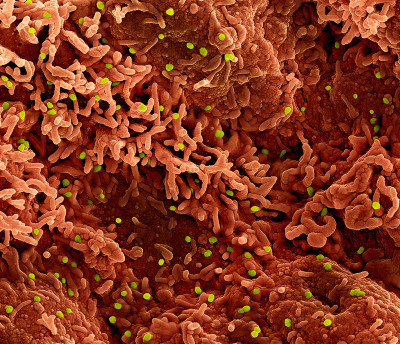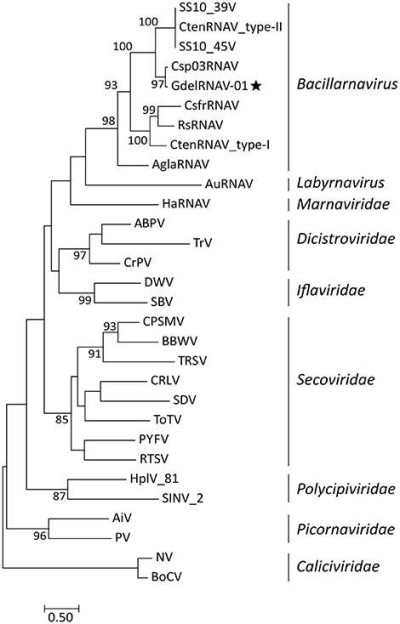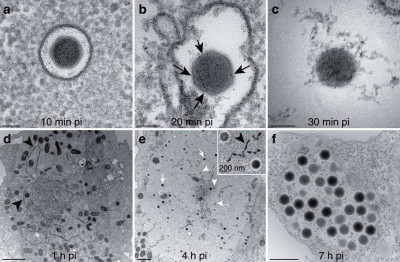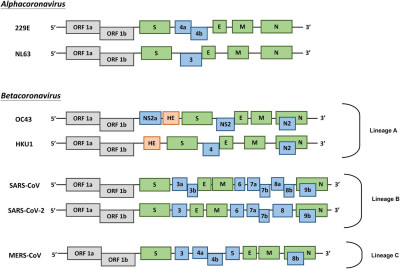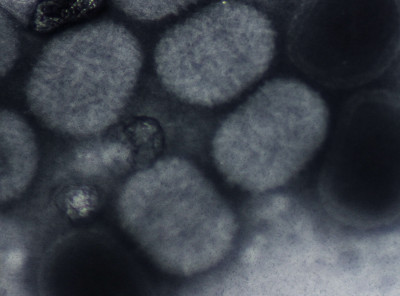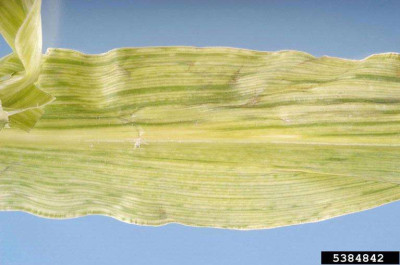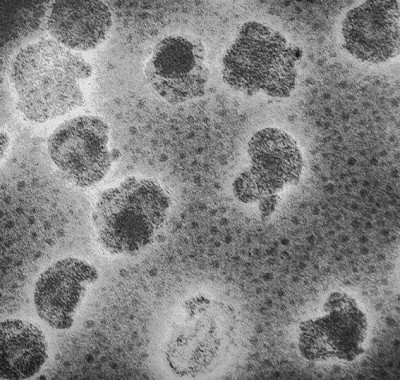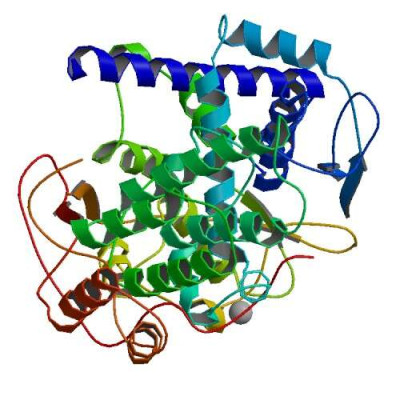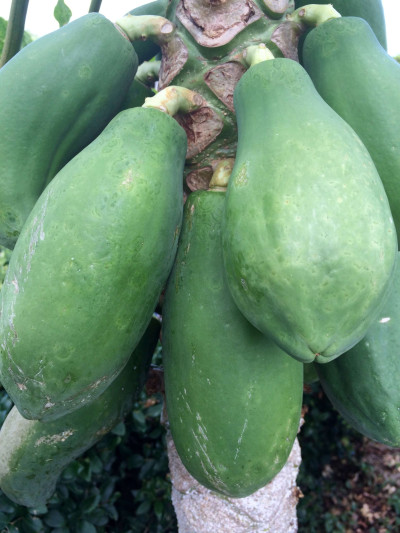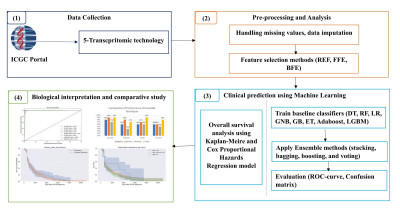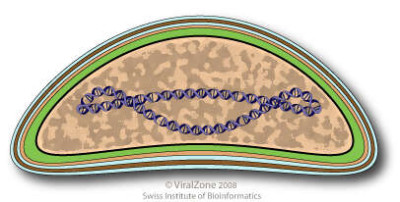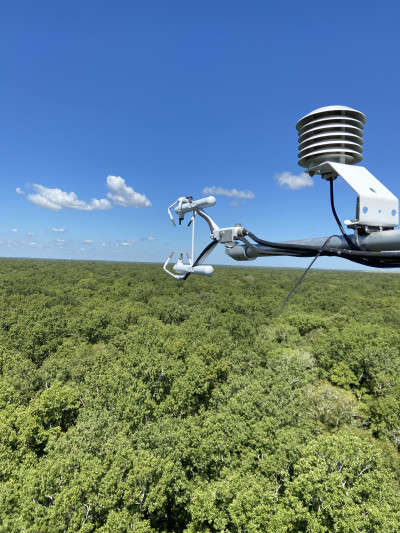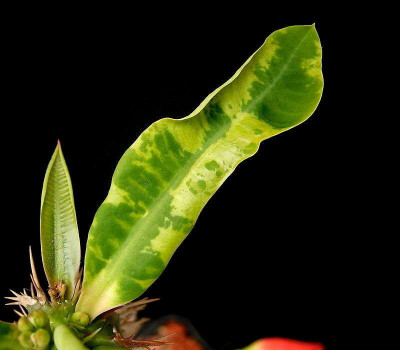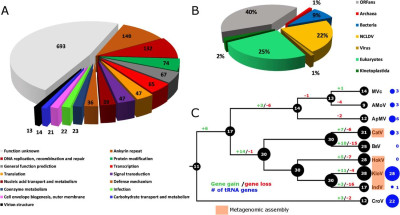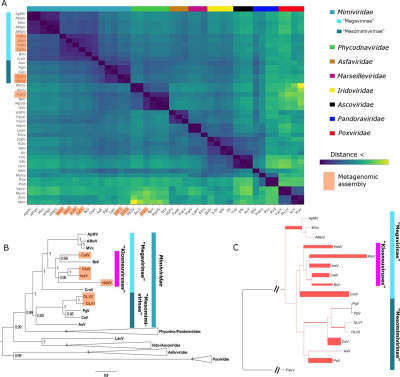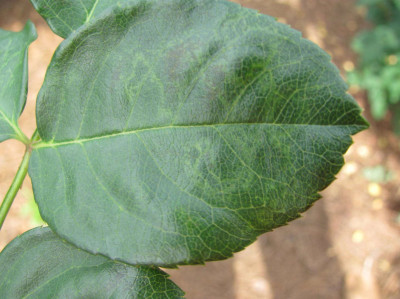Colorized scanning electron micrograph of monkeypox virus (green) on the surface of infected VERO E6 cells (red). Image captured at the NIAID Integrated Research Facility (IRF) in Fort Detrick, Maryland.
Wikimedia Commons, NAID
08 Apr 2024
Phylogenetic rooted tree based on RdRp sequences of representative viruses from the Picornavirales order. Caliciviridae viruses were taken as outgroup. The star indicates the position of GdelRNAV-01 in the genus Bacillarnavirus. The Maximum Likelihood tree was generated using PhyML 3.0 with 1,000 replications and a LG + G + I + F substitution model according to the SMS analyses. Bootstraps values (%) >80 are shown. Scale bar indicates the number of substitutions per site. Virus abbreviations: ABPV, acute bee paralysis virus NC_002548.1; AiV, Aichi virus, AB010145; AglaRNAV, Asterionellopsis glacialis RNA virus NC_024489; AuRNAV, Aurantiochytrium single-stranded RNA virus), BAE47143; BoCV, Bovine enteric calicivirus, AJ011099; BBW, broad bean wilt virus 1 NC_005289.1; CsfrRNAV, Chaetoceros socialis f. radians RNA virus, AB469874; Csp03RNAV, Chaetoceros sp. number03 RNA virus, AB639040; CtenRNAV type-I, Chaetoceros tenuissimus RNA virus, AB375474; CtenRNAV type-II, AB971661; CtenRNAV_SS10V-39V, AB971662; CtenRNAV_SS10V-45V, AB971663; CRLV, cherry rasp leaf virus, NC_006271.1; CPSMV, cowpea severe mosaic virus, NC_003545; CrPV, cricket paralysis virus, NC_003924; DWV, deformed wing virus, NC_004830; HaRNAV, Heterosigma akashiwo RNA virus, NC_005281; HplV-81, Hubei picorna-like virus 81 strain CJLX25805, KX884540.1; HplV-82, Hubei picorna-like virus 82 KX883688.1; PV, human poliovirus 1 Mahoney, V01149; IFV, infectious flacherie virus NC_003781.1; NV, Norwalk virus, M87661; PYFV, Parsnip yellow fleck virus, D14066; RsRNAV, Rhizosolenia setigera RNA virus, AB243297; RTSV, rice tungro spherical virus, AAA66056; SBV, sacbrood virus, NC_002066; SDV, Satsuma dwarf virus RNA 1 NC_003785.2; SINV-2, Solenopsis invicta virus 2 EF428566.1; TRSV, tobacco ringspot virus RNA 1 NC_005097.1; ToTV, tomato torrado virus RNA 1 NC_009013.1; TrV, triatoma virus, NC_003783. [1]
Wikimedia Commons, Laure Arsenieff, Nathalie Simon, Fabienne Rigaut-Jalabert, Florence Le Gall, Samuel Chaffron, Erwan Corre, Emmanuelle Com, Estelle Bigeard, and Anne-Claire Baudoux
12 Apr 2024
Ultrathin-section TEM imaging of Noumeavirus-infected Acanthamoeba cells. (a) 10 min pi, virions have been engulfed and are in vacuoles. (b) 20 min pi, virions in vacuoles exhibit holes (black arrows) in their external translucent shell and appear more spherical. (c) 30 min pi, virions have entirely lost their external shell and appear as spherical electron-dense nucleoids, which can be seen in vacuoles as well as in the cell cytoplasm (black arrows). Scale bar, 100 nm. (d) 1 h pi, electron-dense tubular structures (black arrowheads) appear in the cytoplasm. (e) 4 h pi viral factories (VF) settle in the cell cytoplasm next to the nucleus and the cell organelles are pushed at their periphery (scale bar, 2 μm). The new virions are assembled and the electron-dense mature (white arrows) and immature (white arrowheads) virions are scattered in the same VF. Inset: immature and mature virions inside the VF along with tubular structures (black arrowheads). Scale bar, 200 nm. (f) 7 h pi, the newly synthesized virions are gathered into vacuoles inside the cytoplasm before being released in the extracellular environment (scale bar, 500 nm). [1]
Wikimedia Commons, Elisabeth Fabre, Sandra Jeudy, Sébastien Santini, Matthieu Legendre, Mathieu Trauchessec, Yohann Couté, Jean-Michel Claverie, Chantal Abergel
16 Apr 2024
Genome organization of human coronaviruses (HCoVs). Schematic diagram of seven known HCoVs is shown (not in scale). The genes encoding structural proteins spike (S), envelope (E), membrane (M), and nucleocapsid (N) are in green. The gene encoding haemagglutinin-esterase (HE) in lineage A of betacoronaviruses is in orange. The genes encoding accessory proteins are in blue. [1]
Sin-Yee Fung, Kit-San Yuen, Zi-Wei Ye, Chi-Ping Chan, and Dong-Yan Jin, Wikimedia Commons
23 Feb 2024
An electron micrograph of molluscum contagiousum virus.
Wikimedia Commons, Graham Beards
14 Mar 2024
Symptoms of sugarcane mosaic virus (potyvirus SCMV).
Jeffrey W. Lotz, Florida Department of Agriculture and Consumer Services, Bugwood.org, Wikimedia Commons
15 Mar 2024
Plasmaviridae constitutes a viral family that infects bacteria, with Acholeplasma species acting as their natural hosts. Within this family, there is a singular genus known as Plasmavirus, housing a lone species named Acholeplasma virus L2.
Wikimedia Commons, PhD Dre
24 Jan 2024
RNA-binding protein in the virions of influenzavirus A [1].
Wikimedia Commons, S. Chenavas, L. F. Estrozi, A. Slama-Schwok, B. Delmas, C. Di Primo, F. Baudin, X. Li, T. Crépin, R. W. Ruigrok
25 Jan 2024
The schematic representation of the mammalian orthoreovirus virion. S: small genome segments, M: medium genome segments, L: large genome segments [1].
Wikimedia Commons, Ergin Sahin, Michael E. Egger, Kelly M. McMasters, and Heshan Sam Zhou
25 Jan 2024
Ringspots on fruit on infected plant.
Wikimedia Commons
31 Jan 2024
Electron micrography of numerous rotaviruses.
Graham Beards, Wikimedia Commons
08 Feb 2024
This figure represents the four phases for ensemble methods based on ML algorithms that use transcriptomic technology data to predict skin cutaneous melanoma cancers (SKCM). Figure 1 illustrates the workflow of our integrative study. Figure 1 (1) depicts the data collection source and 5 different transcriptomic technology datasets. Figure 1 (2) illustrates preprocessing and analysis steps. Researchers handled missing data with the MICE imputation technique and applied three methods for best feature selections. Figure 1 (3) represents the experimental achievements of our study using different ML algorithms as baseline classifiers to create an ensemble method. Overall survival was analyzed with the Kaplan–Meier and Cox hazard regression model. Different from traditional methods in existing literature, this research contributes to predicting skin cancer using various ML techniques. The novelty of this research lies in its comprehensive approach, combining high-throughput ML-based ensemble methods with the analysis of multi-omics data, particularly addressing the challenges posed by complex and imbalanced datasets with high dimensionality. Figure 1 (4) shows the biological interpretation and comparative study.
18 Feb 2024
Schematic drawing of an Ascovirus virion. Virions consist of an envelope, a core, and an internal lipid membrane associated with the inner particle. Virion can be bacilliform, ovoidal or allantoid in shape, mesuring about 130 nm in diameter, by 200-400 nm in length. Contains at least 15 different proteins.
ViralZone, SIB Swiss Institute of Bioinformatics, Wikimedia Commons
29 Feb 2024
This image shows the position of an Infrared Gas Analyzer and Sonic Anemometer (IRGASON) at 137 ft. above the ground in a Bottomland Hardwood Forest in Monroe, Louisiana. It measures carbon and water flux exchanged between the forest and atmosphere at a frequency of 10 Hz. This can help us better understand and manage carbon and water cycles in this system for informed management.
08 Mar 2024
Nodaviridae genome map. Segmented, bipartite linear, ssRNA(+) genome composed of RNA1=3.1 kb and RNA2=1.4 kb. Each genome segment 5' end is capped. The 3'end has no poly (A) tract.
ViralZone, SIB Swiss Institute of Bioinformatics, Wikimedia Commons
11 Mar 2024
Euphorbia viguieri infested by Tobacco mosaic virus.
Wikimedia Commons, Frank Vincentz
14 Mar 2024
BsV genome content. (A) Functional assignment of Bodo saltans virus (BsV) genome content based on BLASTp and CDD rps-BLAST (B) Domain of best BLASTp hits (C) Evolutionary history of translational machinery found in giant viruses inferred by COUNT. The size of the black circles mapped on a cladogram of the large members of the Mimiviridae represents the number of protein coding gene families involved in translation at each node or tip. Blue circles indicate the number of tRNA genes found in each genome. Gene gain and loss events are depicted along the branches. Genomes based on metagenomic assemblies are highlighted to indicate the possibility of incomplete representation of the translation machinery. MVc: Megavirus chilensis, AMoV: Acanthamoeba polyphaga Moumouvirus, ApMV: Acanthamoeba polyphaga Mimivirus, CatV: Catovirus, BsV: Bodo saltans virus, HokV: Hokovirus, KloV: Klosneuvirus (KlosnV), IndV: Indivirus, CroV: Cafeteria roenbergensis virus. [1]
Wikimedia Commons, Christoph M. Deeg, Cheryl-Emiliane T. Chow, Curtis A. Suttle
02 Apr 2024
Bodo saltans virus (BsV) Phylogeny. (A) Phylogenetic distance matrix of NCLDV genomes based on whole genome content of gene family presence/absence. Both axes are identical and ‘heat’ of the color increases with dissimilarity in genome content. The shaded ‘taxa’ on the axes indicate viral sequences assembled from metagenomic data. (B) Bayesian posterior consensus tree with Bayesian posterior probability of five concatenated Nucleo-Cytoplasmic Virus Orthologous Groups (NCVOGs) from selected NCLDVs based on two independent MCMC chains (16100 generations rel_diff: 0.104001 effsize: 297). The shaded labels at the end of the branches represent ‘taxa’ based on sequences assembled from metagenomic data (C) Maximum likelihood phylogenetic tree of DNA Polymerase family B of BsV within the Mimiviridae. Branch width correlated to the distribution of 256 metagenomic sequences identified as NCLDV DNA polymerase Family B genes from the TARA oceans project recruited to the tree with pplacer. [1]
Wikimedia Commons, Christoph M. Deeg, Cheryl-Emiliane T. Chow, Curtis A. Suttle
02 Apr 2024
Recording of Ebola viruses using a SEM (Scanning Electron Micrograph).
Wikimedia Commons, CDC
02 Apr 2024
Faint mosaic pattern caused by Prunus Necrotic Ringspot Virus (PNRSV), on "Graham Thomas" ('Ausmas'). We maintain this infected plant at Forest FSC to show the symptoms for teaching purposes. It is the only infected plant in our gardens.
Wikimedia Commons, Malcolm Manners
03 Apr 2024
 Encyclopedia
Encyclopedia
